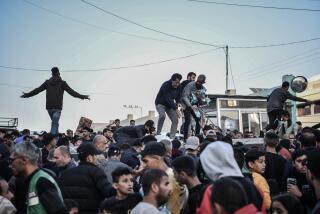Sri Lanka and Rebels in Truce
COLOMBO, Sri Lanka — Under pressure from neighboring India, the five largest Tamil separatist guerrilla groups and the government of this island nation have agreed to a “cessation of violence” as a prelude to political negotiations, Sri Lanka’s national security minister said Tuesday.
If the truce holds up, it will be a significant foreign policy achievement for Indian Prime Minister Rajiv Gandhi, who has been trying for several months to resolve the bloody conflict on this island, which used to be known as Ceylon. Some estimates of the number killed in the last few years range into the thousands, and by official count more than 300 have been killed since mid-May.
The Hindu Tamils--a minority of the 15-million population, which is dominated by the Buddhist Sinhalese community--are concentrated in the northern and eastern parts of the island, across a narrow strait from southern India, where many Tamils also live.
Antipathy between the two communities has grown as the Tamils, complaining of discrimination, have pressed their demands for a separate homeland, to be called Eelam, in the north and east.
The announcement of the cease-fire, said to include the two most active guerrilla groups, the Liberation Tigers of Tamil Eelam and the Tamil Eelam Liberation Organization, and of “the resumption of political dialogue,” was made by National Security Minister Lalith Athulathmudali, who has directed government efforts against the separatists.
“The government has been reliably informed,” a spokesman elaborated, “that major terrorist groups would observe a cease-fire beginning today (Tuesday) and the government has agreed to cautiously go along with it.”
As of Tuesday evening, there had been no confirmation from the various separatist organizations, most of which maintain offices in India. However, informed Indian sources here said at least the leading five guerrilla groups have agreed to abide by the cease-fire.
A spokesman for the leading Tamil political party here, the Tamil United Liberation Front, said, “We welcome the cease-fire, the de-escalation of violence and the restoration of normalcy.”
No major fighting has been reported here since Saturday, when a government raid on a Liberation Tiger stronghold near Mannar resulted in 18 deaths, officials said.
146 Were Slaughtered
The worst episodes of mass killings in the two years of steady violence here have occurred in the past two months as Tamil insurgents and undisciplined government forces exchanged atrocities, according to independent press accounts and a report from an international human rights organization.
On May 14, Tamil terrorists, called “Tiger boys” by rural people, slaughtered 146 unarmed Sinhalese civilians, including children and Buddhist clergy, in the northern city of Anuradhapura, site of a 2,000-year-old tree held sacred by the Sinhalese majority.
In the days that followed, according to press accounts and Amnesty International, mostly Sinhalese police and army units went on rampages, killing as many as 188 Tamil civilians.
The bloody exchanges were typical of the conflict here in which civilians have been the main victims.
The Indian government attempt to resolve the conflict accelerated when Gandhi and Athulathmudali met in New Delhi on Feb. 9. The meeting was encouraged by Vice President George Bush the week before in a W a shington session with Athulathmudali, sources said.
‘Twisted the Arms’
India and Sri Lanka exchanged several delegations before June 2, when Sri Lanka President Junius R. Jayewardene flew to New Delhi to meet with Gandhi and iron out the main elements of a cease-fire that would lead to the first political discussions since the breakdown of talks in December.
According to a senior Sri Lanka government official, India “twisted the arms of the terrorists,” most of whom have their party offices in Madras, capital of India’s Tamil Nadu state.
Informed Indian sources here called the Indian pressure on the Tamil militants “very determined persuasion.”
In the meantime, sources said, Gandhi was able to get a promise from Jayewardene that the Sri Lanka government would consider granting a form of regional autonomy to the Tamil people, who make up about 13% of the island’s population. The degree of autonomy was described as being at least equal to that enjoyed by Indian states.
Autonomy Troublesome
India has a strong interest in not having too much autonomy granted to the Tamils, since any separate state could serve as an inspiration for any number of groups within India that also have separatist tendencies.
Gandhi said in a recent news conference, “We will not allow a separate Eelam,” as Sri Lanka’s Tamils want their state to be known. Furthermore, Gandhi said, the Indian government would not approve a Tamil political unit within Sri Lanka that has powers greater than those enjoyed by any Indian state.
“That made Eelam an impossible dream,” a senior Sri Lankan official said gleefully Tuesday.
Despite the new hopes that the seemingly irresolvable and tragic conflict might come to an end, all parties were restrained and low-key about the reported cease-fire accord.
Athulathmudali, the national security minister, expressed concern that violence might come from the more than two dozen separatist splinter groups not party to the cease-fire. “They might not have got the message,” he said.
Leaders of the Tamils said they fear that the government will use the cease-fire to prepare for greater efforts against the separatists. “Among Tamil groups there is genuine apprehensiveness the cease-fire will be used as a cover to consolidate the government’s military power,” a spokesman said.
Western diplomatic sources also were cautious. “We don’t know for sure what the Indians are up to,” one said. An Indian diplomatic source, meanwhile, would say only that he is “earnestly hopeful.”
More to Read
Sign up for Essential California
The most important California stories and recommendations in your inbox every morning.
You may occasionally receive promotional content from the Los Angeles Times.










